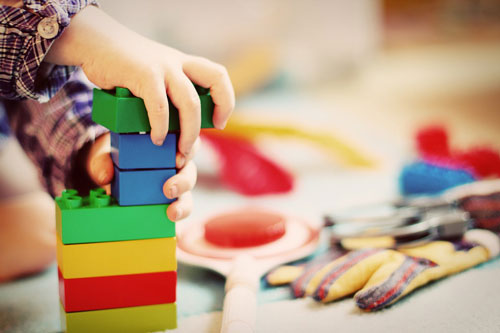My 15 month-old grandson came for a visit recently. He’s a busy little guy – walking (or, rather, running and crashing), chattering and exploring everything. Of course, he loves toys that talk and sing when he pushes the button. After 30 minutes of a squeaky voice singing the same three songs, however, I’ve had it. This visit to grandma’s house was different. Entertainment consisted of a kiddie pool, plastic cups, a squirting rubber ducky, pots and pans, and picture books. He was happy (most of the time), and little did I know that my back-to-basics approach might actually be good for his visual development.
August is National Vision and Learning Month, and the College of Optometrists in Vision Development (COVD) has named this the Summer of Skills. We know that 80% of learning is through vision, but it’s about more than good acuity. The brain must interpret the visual input in a meaningful way. I like to say, “The eye provides; the brain decides.” There is a skill set that must develop for the eye and brain to work together, and it’s never too soon to help a child develop those skills.
 According to the COVD, as children spend more time with digital devices and electronic toys, they have less time to develop basic skills like holding a crayon or using a scissor, as well as eye-hand coordination. While the children may see well, they lack the ability to integrate what they see for depth perception and spatial awareness, among other skills vital for learning and living. To help children hone their visual skills while they enjoy their summer vacation, the COVD recommends some “VISIONary Toys,” and games that may be more familiar to us than electronic toys, not to mention more durable and less expensive.
According to the COVD, as children spend more time with digital devices and electronic toys, they have less time to develop basic skills like holding a crayon or using a scissor, as well as eye-hand coordination. While the children may see well, they lack the ability to integrate what they see for depth perception and spatial awareness, among other skills vital for learning and living. To help children hone their visual skills while they enjoy their summer vacation, the COVD recommends some “VISIONary Toys,” and games that may be more familiar to us than electronic toys, not to mention more durable and less expensive.Remember the card game Go Fish? Played with a simple deck of cards, the game helps to develop visual discrimination, visual memory and visual sequencing. How about good old sidewalk chalk? Drawing helps to develop visual motor skills such as handwriting. The activity books Mom used to give us for long car rides have games like solving mazes that sharpen oculomotor and visual motor skills as well as directionality. Connect the dots games help improve eye tracking, eye-hand coordination and visual closure, which is the ability to recognize a picture when only part of it is seen. Legos help develop fine motor and visual motor skills. For younger children, shape sorters hone visual discrimination, visual motor and fine motor skills.
So let the kids play this summer, but play smarter without electronics. Of course, there has to be time for an eye exam, too, and for some children that means eyewear. You’ll find some great information about the kids' eyewear market, trends that affect children's behaviors and their need for eyewear, key attributes of children's eyewear and how to communicate the right children's eyewear solutions in our free CE Focus on Kids’ Eyewear at 2020mag.com/ce.













